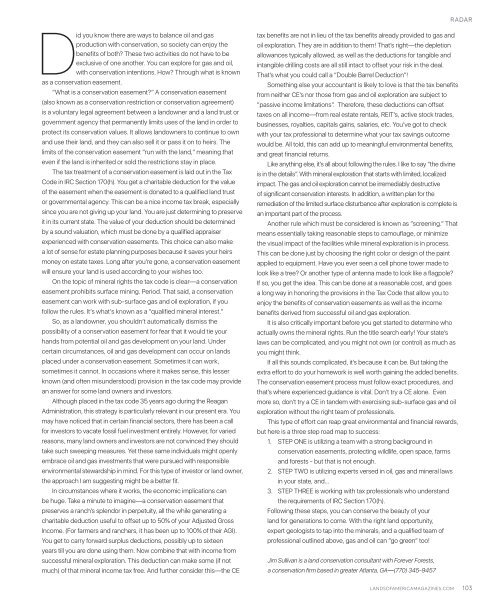You also want an ePaper? Increase the reach of your titles
YUMPU automatically turns print PDFs into web optimized ePapers that Google loves.
RADAR<br />
Did you know there are ways to balance oil and gas<br />
production with conservation, so society can enjoy the<br />
benefits of both? These two activities do not have to be<br />
exclusive of one another. You can explore for gas and oil,<br />
with conservation intentions. How? Through what is known<br />
as a conservation easement.<br />
“What is a conservation easement?” A conservation easement<br />
(also known as a conservation restriction or conservation agreement)<br />
is a voluntary legal agreement between a landowner and a land trust or<br />
government agency that permanently limits uses of the land in order to<br />
protect its conservation values. It allows landowners to continue to own<br />
and use their land, and they can also sell it or pass it on to heirs. The<br />
limits of the conservation easement “run with the land,” meaning that<br />
even if the land is inherited or sold the restrictions stay in place.<br />
The tax treatment of a conservation easement is laid out in the Tax<br />
Code in IRC Section 170(h). You get a charitable deduction for the value<br />
of the easement when the easement is donated to a qualified land trust<br />
or governmental agency. This can be a nice income tax break, especially<br />
since you are not giving up your land. You are just determining to preserve<br />
it in its current state. The value of your deduction should be determined<br />
by a sound valuation, which must be done by a qualified appraiser<br />
experienced with conservation easements. This choice can also make<br />
a lot of sense for estate planning purposes because it saves your heirs<br />
money on estate taxes. Long after you’re gone, a conservation easement<br />
will ensure your land is used according to your wishes too.<br />
On the topic of mineral rights the tax code is clear—a conservation<br />
easement prohibits surface mining. Period. That said, a conservation<br />
easement can work with sub-surface gas and oil exploration, if you<br />
follow the rules. It’s what’s known as a “qualified mineral interest.”<br />
So, as a landowner, you shouldn’t automatically dismiss the<br />
possibility of a conservation easement for fear that it would tie your<br />
hands from potential oil and gas development on your land. Under<br />
certain circumstances, oil and gas development can occur on lands<br />
placed under a conservation easement. Sometimes it can work,<br />
sometimes it cannot. In occasions where it makes sense, this lesser<br />
known (and often misunderstood) provision in the tax code may provide<br />
an answer for some land owners and investors.<br />
Although placed in the tax code 35 years ago during the Reagan<br />
Administration, this strategy is particularly relevant in our present era. You<br />
may have noticed that in certain financial sectors, there has been a call<br />
for investors to vacate fossil fuel investment entirely. However, for varied<br />
reasons, many land owners and investors are not convinced they should<br />
take such sweeping measures. Yet these same individuals might openly<br />
embrace oil and gas investments that were pursued with responsible<br />
environmental stewardship in mind. For this type of investor or land owner,<br />
the approach I am suggesting might be a better fit.<br />
In circumstances where it works, the economic implications can<br />
be huge. Take a minute to imagine—a conservation easement that<br />
preserves a ranch’s splendor in perpetuity, all the while generating a<br />
charitable deduction useful to offset up to 50% of your Adjusted Gross<br />
Income. (For farmers and ranchers, it has been up to 100% of their AGI).<br />
You get to carry forward surplus deductions, possibly up to sixteen<br />
years till you are done using them. Now combine that with income from<br />
successful mineral exploration. This deduction can make some (if not<br />
much) of that mineral income tax free. And further consider this—the CE<br />
tax benefits are not in lieu of the tax benefits already provided to gas and<br />
oil exploration. They are in addition to them! That’s right—the depletion<br />
allowances typically allowed, as well as the deductions for tangible and<br />
intangible drilling costs are all still intact to offset your risk in the deal.<br />
That’s what you could call a “Double Barrel Deduction”!<br />
Something else your accountant is likely to love is that the tax benefits<br />
from neither CE’s nor those from gas and oil exploration are subject to<br />
“passive income limitations”. Therefore, these deductions can offset<br />
taxes on all income—from real estate rentals, REIT’s, active stock trades,<br />
businesses, royalties, capitals gains, salaries, etc. You’ve got to check<br />
with your tax professional to determine what your tax savings outcome<br />
would be. All told, this can add up to meaningful environmental benefits,<br />
and great financial returns.<br />
Like anything else, it’s all about following the rules. I like to say “the divine<br />
is in the details”. With mineral exploration that starts with limited, localized<br />
impact. The gas and oil exploration cannot be irremediably destructive<br />
of significant conservation interests. In addition, a written plan for the<br />
remediation of the limited surface disturbance after exploration is complete is<br />
an important part of the process.<br />
Another rule which must be considered is known as “screening.” That<br />
means essentially taking reasonable steps to camouflage, or minimize<br />
the visual impact of the facilities while mineral exploration is in process.<br />
This can be done just by choosing the right color or design of the paint<br />
applied to equipment. Have you ever seen a cell phone tower made to<br />
look like a tree? Or another type of antenna made to look like a flagpole?<br />
If so, you get the idea. This can be done at a reasonable cost, and goes<br />
a long way in honoring the provisions in the Tax Code that allow you to<br />
enjoy the benefits of conservation easements as well as the income<br />
benefits derived from successful oil and gas exploration.<br />
It is also critically important before you get started to determine who<br />
actually owns the mineral rights. Run the title search early! Your state’s<br />
laws can be complicated, and you might not own (or control) as much as<br />
you might think.<br />
If all this sounds complicated, it’s because it can be. But taking the<br />
extra effort to do your homework is well worth gaining the added benefits.<br />
The conservation easement process must follow exact procedures, and<br />
that’s where experienced guidance is vital. Don’t try a CE alone. Even<br />
more so, don’t try a CE in tandem with exercising sub-surface gas and oil<br />
exploration without the right team of professionals.<br />
This type of effort can reap great environmental and financial rewards,<br />
but here is a three step road map to success:<br />
1. STEP ONE is utilizing a team with a strong background in<br />
conservation easements, protecting wildlife, open space, farms<br />
and forests - but that is not enough.<br />
2. STEP TWO is utilizing experts versed in oil, gas and mineral laws<br />
in your state, and…<br />
3. STEP THREE is working with tax professionals who understand<br />
the requirements of IRC Section 170(h).<br />
Following these steps, you can conserve the beauty of your<br />
land for generations to come. With the right land opportunity,<br />
expert geologists to tap into the minerals, and a qualified team of<br />
professional outlined above, gas and oil can “go green” too!<br />
Jim Sullivan is a land conservation consultant with Forever Forests,<br />
a conservation firm based in greater Atlanta, GA—(770) 345-9457<br />
LANDSOFAMERICAMAGAZINES.COM<br />
103
















